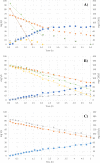Effects of electron acceptors on sulphate reduction activity in activated sludge processes
- PMID: 28547567
- PMCID: PMC5522498
- DOI: 10.1007/s00253-017-8340-3
Effects of electron acceptors on sulphate reduction activity in activated sludge processes
Abstract
The concentration of sulphate present in wastewater can vary from 10 to 500 mg SO42-/L. During anaerobic conditions, sulphate is reduced to sulphide by sulphate-reducing bacteria (SRB). Sulphide generation is undesired in wastewater treatment plants (WWTPs). Previous research indicated that SRB are inhibited by the presence of electron acceptors (such as O2, NO3 and NO2). However, the contact times and concentrations used in those studies are by far higher than occur in WWTPs. Since sulphide can influence the biological nitrogen and phosphorus removal processes, this research aimed to understand how the different electron acceptors commonly present in biological nutrient removal (BNR) systems can affect the proliferation of SRB. For this purpose, a culture of SRB was enriched in a sequencing batch reactor (approx. 88% of the total bacteria population). Once enriched, the SRB were exposed for 2 h to typical concentrations of electron acceptors like those observed in BNR systems. Their activity was assessed using three different types of electron donors (acetate, propionate and lactate). Oxygen was the most inhibiting electron acceptor regardless the carbon source used. After exposure to oxygen and when feeding acetate, an inactivation time in the sulphate reduction activity was observed for 1.75 h. Once the sulphate reduction activity resumed, only 60% of the original activity was recovered. It is suggested that the proliferation of SRB is most likely to occur in BNR plants with an anaerobic fraction higher than 15% and operating at sludge retention times higher than 20 days (at a temperature of 20 °C). These results can be used to implement strategies to control the growth of sulphate reducers that might compete for organic carbon with phosphate-accumulating organisms.
Keywords: Biological nutrients removal; Electron acceptor inhibition; Sulphate reduction activity; Sulphate-reducing bacteria; Wastewater treatment.
Conflict of interest statement
Ethical statement
This study was partially funded by CONACYT [214775].
Conflict of interest
The authors declare that they have no conflict of interest.
Figures





Similar articles
-
Influence of acetate and propionate on sulphate-reducing bacteria activity.J Appl Microbiol. 2014 Dec;117(6):1839-47. doi: 10.1111/jam.12661. Epub 2014 Nov 10. J Appl Microbiol. 2014. PMID: 25290134
-
Upflow anaerobic sludge blanket reactor--a review.Indian J Environ Health. 2001 Apr;43(2):1-82. Indian J Environ Health. 2001. PMID: 12397675 Review.
-
Temperature effect on acetate and propionate consumption by sulfate-reducing bacteria in saline wastewater.Appl Microbiol Biotechnol. 2014 May;98(9):4245-55. doi: 10.1007/s00253-013-5482-9. Epub 2014 Jan 26. Appl Microbiol Biotechnol. 2014. PMID: 24463759
-
Biological inverse fluidized-bed reactors for the treatment of low pH- and sulphate-containing wastewaters under different COD/SO4(2-) conditions.Environ Technol. 2013 May-Jun;34(9-12):1141-9. doi: 10.1080/09593330.2012.737864. Environ Technol. 2013. PMID: 24191446
-
Automated biological sulphate reduction: a review on mathematical models, monitoring and bioprocess control.FEMS Microbiol Rev. 2015 Nov;39(6):823-53. doi: 10.1093/femsre/fuv033. Epub 2015 Jul 29. FEMS Microbiol Rev. 2015. PMID: 26229081 Review.
Cited by
-
Persistent Trace Organic Contaminants Are Transformed Rapidly under Sulfate- and Fe(III)-Reducing Conditions in a Nature-Based Subsurface Water Treatment System.Environ Sci Technol. 2023 Oct 31;57(43):16616-16627. doi: 10.1021/acs.est.3c03719. Epub 2023 Oct 19. Environ Sci Technol. 2023. PMID: 37856881 Free PMC article.
-
Effect of Lactate on the Microbial Community and Process Performance of an EBPR System.Front Microbiol. 2019 Feb 18;10:125. doi: 10.3389/fmicb.2019.00125. eCollection 2019. Front Microbiol. 2019. PMID: 30833933 Free PMC article.
References
-
- Amman RI. In situ identification of micro-organisms by whole cell hybridization with rRNA-targeted nucleic acid probes. In: Ackkermans A, van Elsas J, de Bruijn F, editors. MMEMl. Dordrecht: Klower Academy Publications; 1995.
-
- APHA, AWWA, WEF (2005) Standard methods for the examination of water and wastewater, 22th ed. AWWA
-
- Barton LL, Hamilton WA (2007) Sulphate-reducing bacteria: environmental and engineered systems, Cambridge
MeSH terms
Substances
LinkOut - more resources
Full Text Sources
Other Literature Sources

